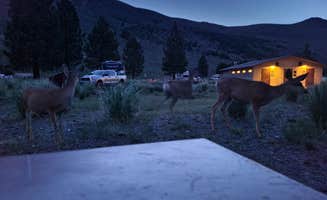Equestrian camping near Ahwahnee, California occurs at elevations between 3,500-7,000 feet, offering diverse terrain for horse riders in the Sierra National Forest and near Yosemite National Park's south entrance. Seasonal temperature variations range from summer highs near 90°F to winter lows below freezing. Access roads to horse-friendly sites typically require high-clearance vehicles with trailers navigating unpaved forest service routes.
What to do
Horseback riding to waterfalls: From Goat Meadow Dispersed Camp Site, riders can access trails leading to several seasonal waterfalls. Located near the south entrance of Yosemite, the area provides connections to both park and forest service trails. "Beautiful scenery, clean, close to Yosemite, and easy to reach," notes Derrick H.
Creek exploration: Multiple water crossings and creek access points exist throughout the Sierra National Forest trails. At Big Sandy Campground, equestrians find shaded sites adjacent to water. "Has a very nice stream that runs right down the middle of campground that basically every site is next to the water. One of my favorite grounds to go and will continue our tradition," writes Leon G.
Mountain trail riding: Numerous trails connect from Sweetwater Campground into higher elevation routes. "Right outside of west exist of Yosemite. Very close to the national park, which was great," mentions Toni K., noting the proximity to extensive trail networks that accommodate horses.
What campers like
Fire rings at primitive sites: Most equestrian camping areas include established fire rings, even at remote locations. "Beautiful area surrounded by trees so lots of shade. Came on 4th of July so the crowd is a lil rowdy but I found a spot farther away which is nice!" reports Taryn R. about Goat Meadow Dispersed Camp Site.
Proximity to trailheads: Horse-friendly campsites are strategically positioned near major riding trails. "Great spot near Yosemite south entrance. Very quite and private," says Clément D. This arrangement allows riders to begin trail journeys directly from camp without trailering horses to separate starting points.
Seasonal accessibility: The higher elevation campsites offer relief from summer valley temperatures. "When we camped 1 car 2 tents on 4/11/25 there were a number of other people and plenty of spots to check out. The area felt safe and easy to access. It's about 1 hour from the valley visitor center," explains Jonathan about dispersed camping options.
What you should know
Limited facilities: Most horse camping areas have minimal amenities. "Rough road in. Please leave it cleaner than you found it. I've seen people complaining that the price is high for such rough camping, but you can have pretty large groups (covered by the 20-something dollar camp fee) and it is a cool spot!" warns Kelly M. about Big Sandy Campground.
Road conditions: Access routes to equestrian sites often require four-wheel drive vehicles. "The road getting there has tons of potholes and the road in the site is super super bumpy," reports Paige about Goat Meadow, emphasizing the need for appropriate towing vehicles.
Water availability: Natural water sources vary seasonally, requiring campers to bring sufficient water for horses. Campers note that creeks may run low or dry by late summer, making spring and early summer optimal for reliable water access at primitive sites.
Tips for camping with families
Space considerations: Family camping with horses requires planning for adequate space. "Quite a large level area, though it was November and not peak season so there were loads of space," notes Kevin T. Choose weekdays or shoulder seasons for less crowded conditions.
Wildlife awareness: Teach children about wildlife safety around horses and campsites. "Coyotes and bears are active in the area—coyotes raided a bag I had hanging from a tree and stole my food!" warns Alexander Mark C., highlighting the importance of proper food storage even with equine companions.
Combined activities: Mix riding with hiking and other recreation. "There are some beautiful waterfall spots about 2 miles of hill climb from campground, well worth the hike. Water can be very cold though," recommends Rosina A. about areas near Sierra National Forest Summit Camp Campground.
Tips from RVers
Site selection for trailers: Horse trailers with living quarters require strategic parking. "Plenty of space for all vehicle sizes. Roads are very accessible. Nice and wooded," reports Ty P., noting that dispersed areas often accommodate larger rigs better than developed campgrounds.
Reservation planning: For established equestrian campgrounds with hookups, book well in advance. "The Corps have added more electric sites over the years and there were 5-6 that fit our 43' Blue Bird. We marked this as 'big rig' friendly," explains Tom D. about COE Eastman Lake Codorniz Campground, one of the few horse-accessible sites with electrical hookups.
Water management: RVers with horses must carefully manage water resources. "You are at least 30 minutes from any stores. The lake is beautiful but the campsites with power and water do not give a view of the lake at all with the exception of 42," advises Candy H., emphasizing the need to arrive with full water tanks for both human and equine needs.



